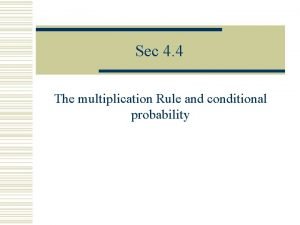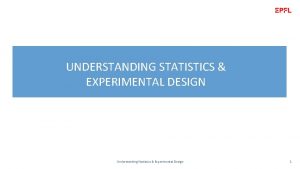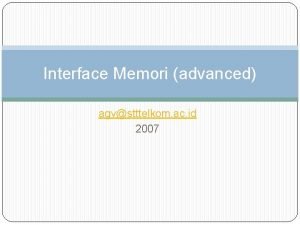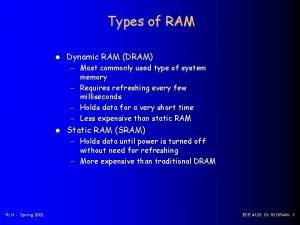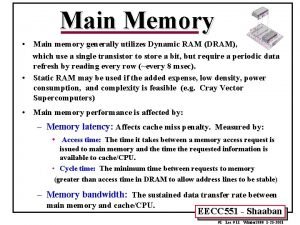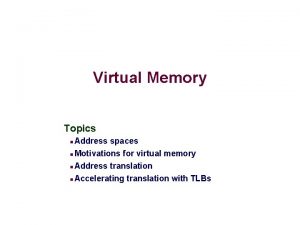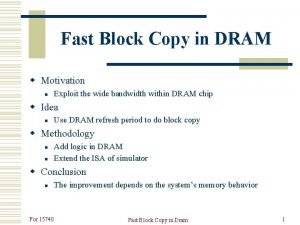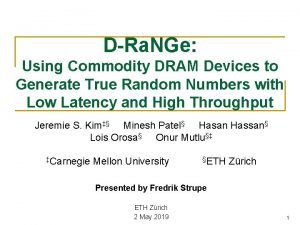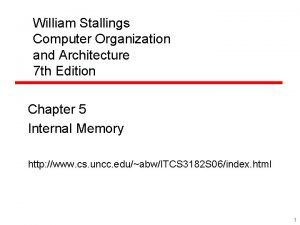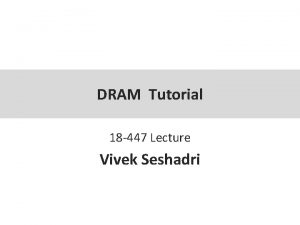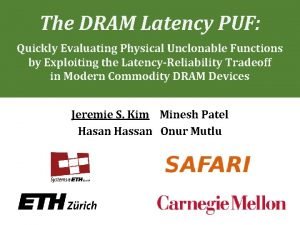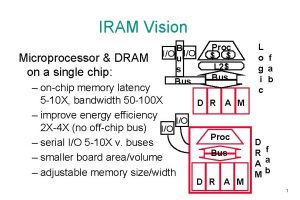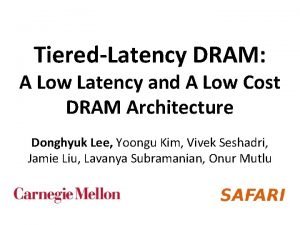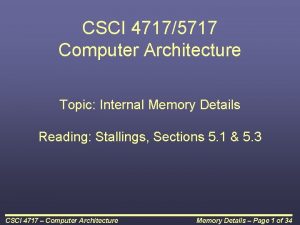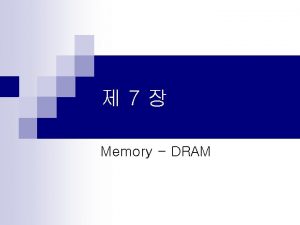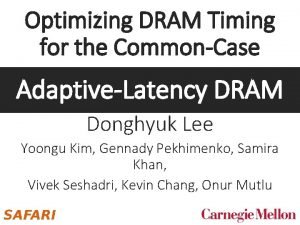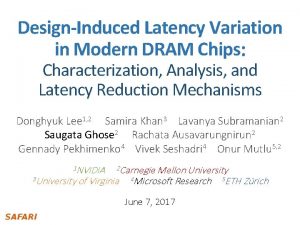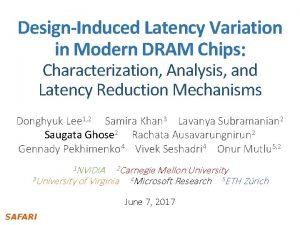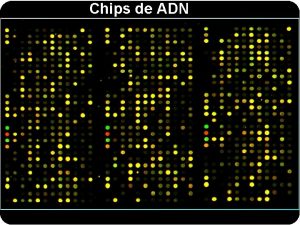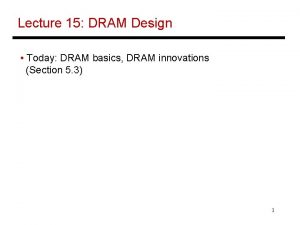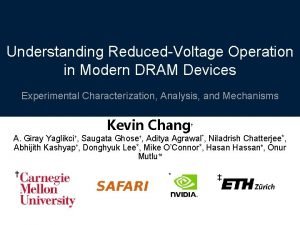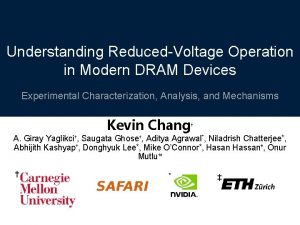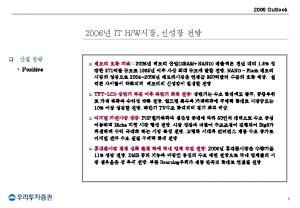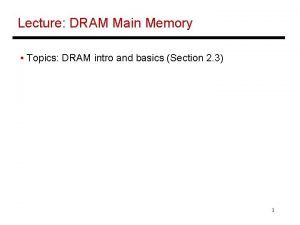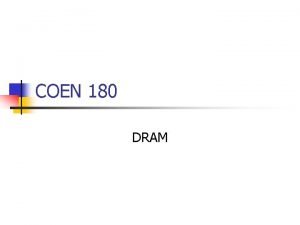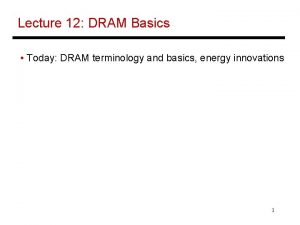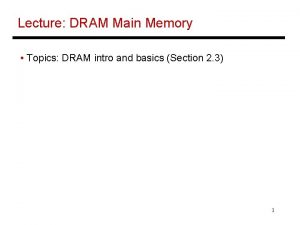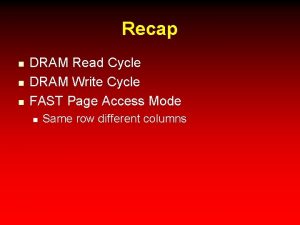Understanding Latency Variation in Modern DRAM Chips Experimental























![FLY-DRAM Evaluation Methodology • Cycle-level simulator: Ramulator [CAL’ 15] https: //github. com/CMU-SAFARI/ramulator • 8 FLY-DRAM Evaluation Methodology • Cycle-level simulator: Ramulator [CAL’ 15] https: //github. com/CMU-SAFARI/ramulator • 8](https://slidetodoc.com/presentation_image/0f16a278f8bdc0d7007986051659d83c/image-24.jpg)













- Slides: 37

Understanding Latency Variation in Modern DRAM Chips Experimental Characterization, Analysis, and Optimization Kevin Chang Abhijith Kashyap, Hasan Hassan, Saugata Ghose, Kevin Hsieh, Donghyuk Lee, Tianshi Li, Gennady Pekhimenko, Samira Khan, Onur Mutlu v 1. 3

Main Memory Latency Lags Behind Improvement Capacity 100 Bandwidth Latency 64 x 16 x 10 1. 2 x 1 1999 2003 2006 2008 2011 2013 2014 2015 Long DRAM latency → performance bottleneck In-memory DB, Spark, JVM, … [Clapp+ (Intel), IISWC’ 15] Google warehouse-scale workloads [Kanev+ (Google), ISCA’ 15] 2

Why is Latency High? • DRAM latency: Delay as specified in DRAM standards – Doesn’t reflect true DRAM device latency • Imperfect manufacturing process → latency variation DRAM A DRAM B DRAM C Standard • High standard latency chosen to increase Latency yield Manufacturing Variation Low High DRAM Latency 3

Goals 1 Understand characterize latency variation in modern DRAM chips 2 Develop a mechanism that exploits latency variation to reduce DRAM latency 4

Outline • • • Motivation and Goals DRAM Background Experimental Methodology Characterization Results Mechanism: Flexible-Latency DRAM Conclusion 5

High-Level DRAM Organization DRAM Channel DRAM chip DIMM (Dual in-line memory module) 6

… DRAM Chip Internals DRAM Cell … … Row Buffer 8 KB (128 cache lines) 7

DRAM Operations 1 1 ACTIVATE: Store the row into the row buffer 2 READ: Select the target cache line and drive to CPU 3 PRECHARGE: Prepare the array for a new ACTIVATE 1 to CPU 8

DRAM Timing Parameters 1 Activation latency: t. RCD (13 ns / 50 cycles) 2 Precharge latency: t. RP (13 ns / 50 cycles) Command Data ACTIVAT E PRECHARG E READ 1111 Cache line (64 B) Duration Next ACT 9

DRAM Latency Variation Imperfect manufacturing process → latency variation DRAM A DRAM B DRAM C Slow cells Low High DRAM Latency 10

Experimental Questions Imperfect manufacturing process → latency variation Can we show latency variation in these parameters? How large is latency variation in modern DRAM chips? Can we identify the properties of slow cells with long latency? Can we isolate slow cells to make DRAM faster? 11

Experimental Methodology • Tool that enables us to freely issue DRAM commands – Existing systems: Commands are generated and controlled by HW • Custom FPGA-based infrastructure PCIe DDR 3 PC FPGA C++ programs to specify commands Generate command sequence DIMM 12

Experiments • Swept each timing parameter to read data – Time step of 2. 5 ns (FPGA cycle time) • Quantified timing errors: bit flips when using reduced latency • Tested 240 DDR 3 DRAM chips from three vendors – – 30 DIMMs Manufacturing dates: 2011 – 2013 Capacity: 1 GB Ambient temperature: 20 o. C 13

Outline • • Motivation and Goals DRAM Background Experimental Methodology Characterization Results – Activation latency – Precharge latency • Mechanism: Flexible-Latency DRAM • Conclusion 14

Activation Latency: Key Observation: ACT errors are isolated in the cells read in the first cache line 1 1 Row Buffer 1 ? 1 0 Second read w/ 1 sufficient activation time Not fully activated t. RCD Command ACTIVAT E XREAD Actual ACT Time READ 15

Variation in Activation Errors Results from 7500 rounds over 240 chips Max No ACT Errors Many errors Rife w/ errors Quartiles Very few errors Min 13. 1 ns standard Moderncharacteristics DRAM chipsacross exhibit Different significant DIMMsvariation in activation latency 16

Spatial Locality of Activation Errors One DIMM @ t. RCD=7. 5 ns Activation errors are concentrated at certain columns of cells 17

Strong Pattern Dependence DIMM A DIMM B DIMM C > 4 orders of magnitude Row buffer design is biased towards 1 over 0 [Lim+, ISSCC’ 12] Activation errors have a strong dependence on the stored data patterns 18

Precharge Latency: Key Observation: PRE errors occur in multiple cache lines in the row activated after a precharge 1 0 1 0 0 Row Buffer 1 1 1 0 1 Not fully precharged Incorrectly sensed data t. RP Command PRECHAR GE ACTIVATE Actual PRE Time 19

Variation in Precharge Errors Results from 4000 rounds over 240 chips Many errors No PRE Errors Rife w/ errors Few errors 13. 1 ns standard Different characteristics across Modern DRAM chips exhibit DIMMs significant variation in precharge latency 20

Spatial Locality of Precharge Errors One DIMM @ t. RP=7. 5 ns Precharge errors are concentrated at certain rows of cells 21

Outline • • • Motivation and Goals DRAM Background Experimental Methodology Characterization Results Mechanism: Flexible-Latency DRAM Conclusion 22

Mechanism to Reduce DRAM Latency • Observations – DRAM timing errors are concentrated on certain regions – All cells operate without errors at 10 ns t. RCD and t. RP • Flexible-Latenc. Y (FLY) DRAM – A software-transparent design that reduces latency • Key idea: 1) Divide memory into regions of different latencies 2) Memory controller: Use lower latency for regions without slow cells; higher latency for other regions 23
![FLYDRAM Evaluation Methodology Cyclelevel simulator Ramulator CAL 15 https github comCMUSAFARIramulator 8 FLY-DRAM Evaluation Methodology • Cycle-level simulator: Ramulator [CAL’ 15] https: //github. com/CMU-SAFARI/ramulator • 8](https://slidetodoc.com/presentation_image/0f16a278f8bdc0d7007986051659d83c/image-24.jpg)
FLY-DRAM Evaluation Methodology • Cycle-level simulator: Ramulator [CAL’ 15] https: //github. com/CMU-SAFARI/ramulator • 8 -core system with DDR 3 memory • Benchmarks: SPEC 2006, TPC, STREAM, random – 40 8 -core workloads • Performance metric: Weighted Speedup (WS) 24

Fraction of Cells FLY-DRAM Configurations 100% 80% 60% 40% 20% 0% t. RCD 93% 12% Baseline (DDR 3) Fraction of Cells 13 ns 10 ns 7. 5 ns 99% 100% 80% 60% 40% 20% 0% D 1 D 2 D 3 Profiles of 3 real DIMMs Upper Bound t. RP 74% 13 ns 10 ns 7. 5 ns 99% 13% Baseline (DDR 3) D 1 D 2 D 3 Upper Bound 25

Results Normalized Performance 1. 25 1. 2 1. 15 1. 1 1. 05 1 0. 95 19. 7% 19. 5% 17. 6% 13. 3% Baseline (DDR 3) FLY-DRAM (D 1) FLY-DRAM (D 2) FLY-DRAM (D 3) Upper Bound performance 0. 9 FLY-DRAM improves by exploiting 40 latency Workloads variation in DRAM 26

Other Results in the Paper • Error-correcting codes (ECC) – Effective at correcting activation errors • Restoration latency – Significant margin to complete without errors • Effect of temperature – Difference is not statistically significant to draw conclusion 27

Conclusion • First to experimentally demonstrate and analyze latency variation behavior within real DRAM chips • Show across 240 DRAM chips that: – All cells work below standard latency – Some regions of cells work even faster, but slow cells in other regions start to fail – Error rate is data-dependent • FLY-DRAM reduces latency by using low latency for regions without slow cells and high https: //github. com/CMU-SAFARI/DRAM-Latency-Variation-Study 28

Understanding Latency Variation in Modern DRAM Chips Experimental Characterization, Analysis, and Optimization Kevin Chang Abhijith Kashyap, Hasan Hassan, Saugata Ghose, Kevin Hsieh, Donghyuk Lee, Tianshi Li, Gennady Pekhimenko, Samira Khan, Onur Mutlu

BACKUP SLIDES 30

Infrastructure Temperature Controller FPGA DIMM Heater 31

DRAM DIMMs 32

Activation Latency Variation by DRAM Models 33

Activation Errors in Data Bursts 34

Effect of ECC on Activation Errors 35

Activation Errors by Temperature 36

Precharge Latency Variation by DRAM Models 37
 Multiplication rule
Multiplication rule A box contains black chips and white chips
A box contains black chips and white chips Latency variation
Latency variation Experimental vs nonexperimental research
Experimental vs nonexperimental research Experimental vs non experimental
Experimental vs non experimental Experimental vs non experimental
Experimental vs non experimental Descriptive vs correlational vs experimental research
Descriptive vs correlational vs experimental research Disadvantages of experimental research
Disadvantages of experimental research Coefficient of determination formula in regression
Coefficient of determination formula in regression Direct variation constant of variation
Direct variation constant of variation Direct variation vs inverse variation
Direct variation vs inverse variation Statistics
Statistics Understanding standards advanced higher english
Understanding standards advanced higher english Advanced higher modern studies
Advanced higher modern studies Dram organization
Dram organization Dram scaling
Dram scaling Struktur dram
Struktur dram Pengertian dram
Pengertian dram Dynamic ram types
Dynamic ram types Cache
Cache Arch shield
Arch shield Virtual address
Virtual address Dram cell
Dram cell Dram block diagram
Dram block diagram Dram in computer architecture
Dram in computer architecture Azerbaycanda ilk dram eseri
Azerbaycanda ilk dram eseri Virtual memory tlb
Virtual memory tlb Dram
Dram Advanced dram organization
Advanced dram organization Dram tutorial
Dram tutorial Dram puf
Dram puf Istoreos
Istoreos Dram
Dram Internal memory in computer architecture
Internal memory in computer architecture Dram ras cas
Dram ras cas Dram timing mode
Dram timing mode Liquor liability insurance pennsylvania
Liquor liability insurance pennsylvania Dram 301
Dram 301
